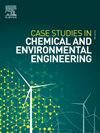高收率葡萄糖酸浸出和回收废旧锂离子电池中的有价金属
Q1 Environmental Science
Case Studies in Chemical and Environmental Engineering
Pub Date : 2025-07-29
DOI:10.1016/j.cscee.2025.101271
引用次数: 0
摘要
这项研究强调了有机酸作为传统无机浸出剂的环境可持续替代品的日益相关性。除了减少浸出过程的生态足迹外,有机酸还提高了金属回收的选择性和效率。其中,葡萄糖酸已被证明是一种特别有效的萃取贵重金属的药剂。通过统计优化,该浸出工艺从报废锂离子电池(eol - lib)中提取锂、镍、钴和锰的效率超过98%,同时显著限制了铜、铁和铝的共溶。随后,使用草酸和硫化物剂选择性地通过沉淀回收镍、钴和锰。草酸表现出高选择性,将锂和铝留在溶液中,并使镍、钴和锰的回收率分别达到99%、100%和86%。硫化物沉淀同样有效,在pH为4时镍和钴的回收率超过97%。该工作巩固了目前的知识葡萄糖酸为基础的浸出,并系统地评估其与传统沉淀方法的组合。虽然葡萄糖酸盐基质中会发生复杂的化学相互作用,但本研究实现了较高的提取和回收效率,证明了这种组合方法在现有工业回收系统中的实用性和潜在集成。本文章由计算机程序翻译,如有差异,请以英文原文为准。
High yield gluconic acid leaching and recovery of valuable metals from end-of-life lithium-ion batteries
This study underscores the increasing relevance of organic acids as environmentally sustainable alternatives to conventional inorganic leaching agents. Beyond reducing the ecological footprint of leaching processes, organic acids offer improved selectivity and efficiency in metal recovery. Among them, gluconic acid has proven to be a particularly effective agent for the extraction of valuable metals.
Through statistical optimization, the leaching process achieved extraction efficiencies exceeding 98 % for lithium, nickel, cobalt, and manganese from end-of-life lithium-ion batteries (EoL-LIBs), while significantly limiting the co-dissolution of copper, iron, and aluminum.
Subsequently, nickel, cobalt, and manganese were selectively recovered through precipitation using oxalic and sulphide agents. Oxalic acid demonstrated high selectivity, leaving lithium and aluminum in solution, and enabling recovery rates of 99 %, 100 %, and 86 % for nickel, cobalt, and manganese, respectively. Sulphide precipitation was similarly effective, achieving over 97 % recovery of nickel and cobalt at pH 4.
The work consolidates current knowledge on gluconic acid-based leaching and systematically evaluates its combination with conventional precipitation methods. Although complex chemical interactions in gluconate matrices occur, this study achieves high extraction and recovery efficiencies, demonstrating the practicality and potential integration of this combined approach into existing industrial recovery systems.
求助全文
通过发布文献求助,成功后即可免费获取论文全文。
去求助
来源期刊

Case Studies in Chemical and Environmental Engineering
Engineering-Engineering (miscellaneous)
CiteScore
9.20
自引率
0.00%
发文量
103
审稿时长
40 days
 求助内容:
求助内容: 应助结果提醒方式:
应助结果提醒方式:


